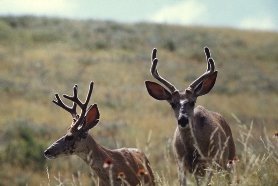Habitat

The mule deer is an extremely adaptable animal. They inhabit open grasslands, agricultural land, shrublands, woodlands, mountain forests, semi-deserts, and high mountain ecosystems. Even though mule deer can inhabit all of these ecosystems, their range is restricted. They reside in North America west of the 100th meridian from 23 degrees to 60 degrees north.
The land mule deer inhabit needs to meet several requirements. It must have adequate Nutrition, hiding and thermal cover, and access to fresh water. Hiding cover is vegetational cover or terrain that provides a chance for the mule deer to escape from predators such as mountain lions, wolves, and coyotes. Thermal cover may consist of brush or tree thickets that offer protection from harsh weather. Odocoileus can get its water from springs, lakes, wetland ponds, rivers or streams. They may also consume snow in the winter.
Typically, mule deer have home ranges. Adult does
tend to have ranges of about 0.3 to 1.2 square miles. The home range of a
buck is about 1.2 to 4 square miles but may be as large as 30 square miles.
The vast area mule deer inhabit is diminishing. Due to urban and rural development, agriculture, logging, grazing and oil and gas development, about 2,500 acres of suitable mule deer habitat is lost daily.
